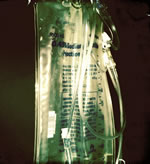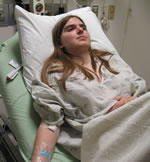You scored 0 marks out of 4.
This patient is suffering from diabetic ketoacidosis. She recently developed an infection with systemic symptoms and missed several doses of her short-acting insulin, and it is likely that these factors precipitated her illness. Diabetic ketoacidosis is a medical emergency and prompt treatment is essential.
Adults with diabetic ketoacidosis should be managed according to the guidelines produced by the Joint British Diabetes Societies Inpatient Care Group. These guidelines are summarised in the BNF.
In the scenario below, review the initial treatment of the patient and decide how best to continue her management:
 IV access was established and treatment was commenced with sodium chloride 0.9% 1000 mL over 1 hour and an infusion of soluble insulin 0.1 unit/kg/hour. The patient is receiving antibiotic treatment for her urinary tract infection and is being continuously monitored. Serum biochemistry shows K+ 4.1 mmol/L (3.5-4.9).
IV access was established and treatment was commenced with sodium chloride 0.9% 1000 mL over 1 hour and an infusion of soluble insulin 0.1 unit/kg/hour. The patient is receiving antibiotic treatment for her urinary tract infection and is being continuously monitored. Serum biochemistry shows K+ 4.1 mmol/L (3.5-4.9).
The initial infusion of 1000 mL sodium chloride 0.9% is complete. How should the patient's fluid replacement proceed? Select ONE option.
 Treatment with fluid/electrolyte replacement and insulin continues for several hours, during which glucose 10% 125 mL/hour IV is prescribed to prevent hypoglycaemia. The patient still feels nauseated but her blood results are steadily improving, with venous pH 7.28 (7.35-7.45) and ketones 0.7 mmol/L (< 0.5).
Treatment with fluid/electrolyte replacement and insulin continues for several hours, during which glucose 10% 125 mL/hour IV is prescribed to prevent hypoglycaemia. The patient still feels nauseated but her blood results are steadily improving, with venous pH 7.28 (7.35-7.45) and ketones 0.7 mmol/L (< 0.5).
A colleague suggests converting the patient from IV to subcutaneous insulin. Is this treatment appropriate?
 Treatment continues for several more hours, during which the patient's becomes biochemically stable, starts eating and is converted from IV to subcutaneous insulin. She now feels well and has been pronounced medically fit for discharge.
Treatment continues for several more hours, during which the patient's becomes biochemically stable, starts eating and is converted from IV to subcutaneous insulin. She now feels well and has been pronounced medically fit for discharge.
The patient asks if she can leave hospital. Is there anything that should be arranged first?
Diabetic Ketoacidosis
A state characterised by hyperglycaemia, ketonaemia and metabolic acidosis. It typically occurs secondary to insulin deficiency and the consequent rise in levels of glucagon, adrenaline, cortisol and other 'counter-regulatory' hormones. These endocrine changes increase the rate of hepatic glycogenolysis and gluconeogenesis, lipolysis of adipose tissue, and muscle proteolysis.